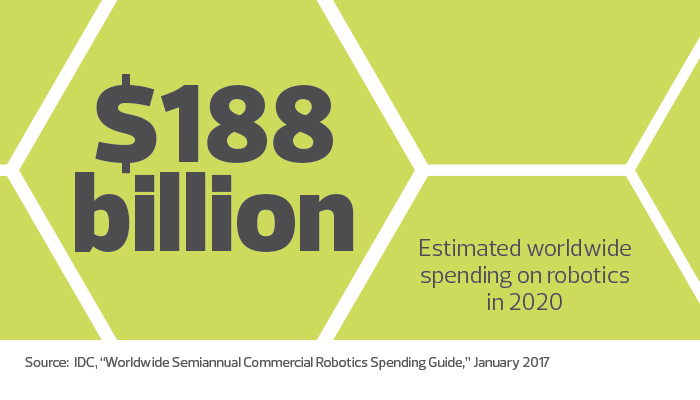Today’s robots can perform more complex tasks than robots of a decade ago, and they’re at work in a variety of industries. With increased complexity and usage growth in mind, the scope of robotics research is expanding.
Several advancements have fueled robotics development, including Internet of Things connectivity that permits devices to be mobile, says John Santagate, a research manager at IDC.
“The growth today is a function of the technology that surrounds robotics: sensors, artificial intelligence, improvements in safety and software,” he says. “That’s really driving the current levels of adoption.”
More Streamlined Software Eases Communication
Standardized software now makes it easier for various components of a robotic system to communicate, says Cornelia Fermuller, an associate research scientist at the University of Maryland Institute for Advanced Computer Studies and instructor at the Maryland Robotics Center.
“If I want a robot to pick something up, a camera has to point at it and give me the images, and those images have to be passed to software that controls the arm and maybe plans how it moves. The planning software has to call the arm, and the arm starts executing,” Fermuller says. “Before, I’d have to do every stage from scratch. Now, the vision and the executor talk to each other.”

In recent years, UM researchers have pursued exploratory projects, ranging from developing a robotic system that learns to cook by watching online videos to creating Robo Raven, a robotic bird. Much of their current work involves robots interacting with unstructured environments, says Sarah Bergbreiter, the center’s director and an associate professor of mechanical engineering.
Industry Experts Needed for Robotic Future
Unlike a factory setting, where robots might be stationary, unstructured environments require robots to perceive and avoid obstacles as they move around an area. For example, a robot might be equipped with a processing architecture that allows it to reason and learn how to respond to complex goals.
“The idea is being able to perceive your world. That requires a lot of computation and computer vision — a lot of emphasis on use, for example, of graphics processing, sensor processing and learning algorithms,” Bergbreiter says. “Robotics has changed quite a bit in the last decade or two. We’re moving away from the paradigm of giant robots to smaller, more social robots being used in applications beyond manufacturing and defense.”

Some institutions are already preparing for this emerging field. At the University of Michigan, construction of the $75 million Ford Motor Company Robotics Building is under way, and the University of Pennsylvania has launched an online robotics course.
“In the future, there will be far more robotics and, therefore, a demand for folks who understand how to engineer from a mechanical and application perspective,” Santagate says. “Autonomous vehicles, warehouse robotics, medical robotics — all of those areas are going to take off. There’s going to be a lot of incentive for academic institutions to train students.”